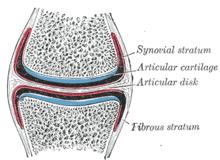Articular disc
A discus articularis (or also Fibrocartilago interarticularis from Latin articular disc) is an inter- joint disc (similar to the menisci ) made up of fibrous cartilage and tight, parallel- fiber connective tissue , which usually divides the joint cavity into two separate chambers.
Joint discs are usually free of nerves and blood vessels ; they are nourished by diffusion from the joint fluid ( synovia ).
function
Joint discs have several tasks. They serve to enlarge the contact area between the joint parts. Furthermore, they compensate for inequalities ( incongruences ) of the joint surfaces and additionally buffer and distribute the pressure on the joint . They also help guide the joint head in the socket.
Examples
Typical examples of flexible disks are located
- in the sternum-clavicle joint or sternoclavicular joint ( articulatio sternoclavicularis ) between the collarbone ( clavicle ) and breastbone ( sternum ),
- in the shoulder joint ( articulatio acromioclavicularis ) between the clavicle and shoulder blade ( scapula ),
- between ulna and triangular leg as well
- in the TMJ ( temporomandibular joint ) between the lower jaw ( mandible ) and temporal bone ( temporal Os ).
While the first three are absent in most mammals , the joint disc is formed in the temporomandibular joint in all mammals. Disci are already used in fish, e.g. B. on the upper jaw in barbed fish .
See also
The articular disc should not with a intervertebral disc ( disc be confused).
